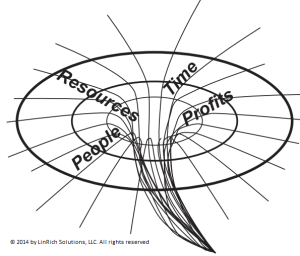
At LinRich Solutions, we tend to use analogies to help convey some of our ideas. One of our favorite analogies is using astronomy’s “event horizon” to describe the point when an organization suddenly realizes that their project is in serious jeopardy. According to Google, an “event horizon” is “a theoretical boundary around a black hole beyond which no light or other radiation can escape.” For us, the “Project Event Horizon” is a crisis-induced boundary around a project where no people, money or other resources can escape.
In the Oil & Gas manufacturing industry, the Project Event Horizon is a very common occurrence. But what steps lead up to it?
- The manufacturer makes a promise, in the form of a quote, that hasn’t been fully planned, coordinated or vetted by the people that will actually have to do the work (primarily operations, engineering and project management).
- The customer issues a purchase order.
- A few weeks (or months!) pass and a kickoff meeting with sales, operations, engineering and project management takes place. The operations manager says bills of material must be released today if there is going to be any chance of making the promised delivery date and the engineering manager says that the bills won’t be released for at least another two months. Everybody then looks expectantly at the project manager, who in turn looks around the room for an escape hatch. The handover meeting ends with no real understanding of the likely finish date. A great sense of foreboding hangs over the project team.
- A few more weeks or months pass as focus remains on finishing existing orders. Engineering starts releasing bills of material and operations starts expediting vendors and authorizes overtime on the shop floor.
- The costs—which usually aren’t tracked in real time—start piling up.
- Vendor delivery dates inevitably slip. There’s rework on the shop floor. The finish date keeps moving out.
- The customer calls to arrange the testing and pick up of the finished product. The customer suddenly finds out that it will likely be a few more months until the product will be ready to ship. But nobody really knows because the schedule isn’t detailed enough and the finish date keeps moving out as more activities get added. Inevitably, a very uncomfortable CEO to CEO “conversation” takes place.
- The Project Event Horizon materializes.
So what happens during the Project Event Horizon? In summary, the cost curve, which was already steep, now goes exponential. Resources get sucked into the project as every effort is made up and down and across the supply chain to improve the delivery date, even at the expense of other customer orders. There’s surprise, bewilderment and then anger as the likely costs become bounded and any expectations for profitability turn to desperate prayers for breaking even. There’s additional stress all around because the customer installs a full time representative on site who asks painful questions daily (and in some cases, attempts to re-direct shop work!). A huge toll on employee’s personal lives is imposed too, which is something that’s hard to quantify but still very real as folks work long hours and weekends to expedite delivery at the expense of families and friends.
At some point, the project finally finishes and there’s a collective sigh of relief. But the true costs might never be known and the lessons never learned. Why? Because the CEO from a different company with a different project calls over screaming about late deliveries and a new Project Event Horizon materializes, which draws in all those resources that could have been figuring out exactly what went wrong on the last project and—most importantly—how to prevent it from ever happening again.
© 2014 by LinRich Solutions, LLC. All rights reserved


